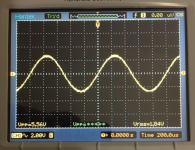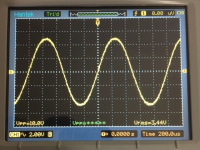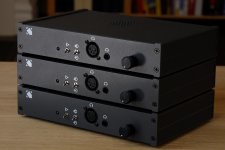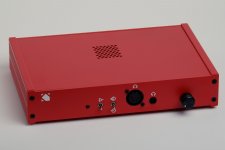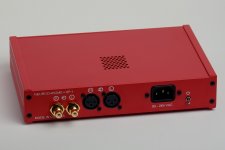I'll get measurements shortly - it's quite obvious that the increased max SPL achievable went up significantly by ear. The volume knob used to be able to go up to max on the DAC and now it's about at half way before it's uncomfortably loud.
I don't understand your objections to putting a signal generator and a voltmeter on it and actually quantifying your results. The measurement takes a few seconds to make. Maybe five minutes if you have to set up the measurement first.
I understand the whole 24-hour/day thing. I can also empathize with getting excited and wanting to share "data" even though hard data doesn't yet exist.
I do understand that some view the correlation between good measurements (plural) and good listening experience with skepticism. I disagree but respect their opinion. However, "designing" a circuit without even measuring the output power or even looking at the output waveform on an oscilloscope and then making claims about increased power (or other performance parameters) is basically the blind leading the blind through a minefield in the dark. It is certainly more risk than I'm willing to take on. You can have a circuit that sounds great but oscillates at 100 MHz (been there, done that). It may work fine with some headphones but fry others. If you're planning to offer your designs for sale, I strongly encourage you to measure the crap out of the circuit to make sure you never ever get that support call starting out with, "Um... Yeah.... Your amp fried my $5k headphones. Now what?" At least I don't ever want to end up in that position, which is one of the reasons I apply the same level of engineering and expertise to my Neurochrome designs as I used when working for National Semiconductor and TI when my circuits were mass-produced by the hundreds of thousands if not millions.
If you intend to play in the DIY market, you'll also have some savvy DIYers out there who'll measure the crap out of your circuit to hone their measurement skills and perhaps keep the honest people honest. If you guess your "specs" based on "should" and "probably" you'll likely have some angry forum posts to deal with. This can kill your business before it even gets off the ground. Just saying...
My amp is a single ended Class A with a MOSFET source follower. The ZVN4306GTA MOSFET is tied to two 9v Li-ions batteries which I am quite sure, are capable of flowing more than the 55mA bias current.
"I'm sure are capable". You're probably right, but you don't actually know the limit. Also, if you're marketing your amp as "Class A", the peak output current is equal to the quiescent current (55 mA in your case if I understand you correctly) by definition. Even if the batteries can deliver more, the circuit will exit Class A once the load current exceeds the quiescent current. That's fundamental output stage design knowledge here.
The source follower is great at sourcing current. It won't sink more current than its quiescent current, though. Nothing wrong with that but it does impose a limit on the output current and will result in asymmetrical clipping behaviour.
The ZVN4306 itself, is capable of several amps current, and. in non-balanced drive, max signal is limited by clipping due to single rail being at 16v or so with max output at 10v peak to peak and bias around 55mA.
The gate driver will limit the swing as well. MOS is hard that way. That 4-6 V Vgs is painful for your headroom. In the low voltage space you do have some options with lower Vgs which may be helpful for you. The 3-4 V Vgs of the ZVN4306 is nice but with only 18 V supply to play with, you're eating up headroom fast. See Figure 1 of the ZVN4306 data sheet for details.
Although this is getting a bit extended OT discussion in Tom's thread.
Agreed.
So I will have to wife up a load resistor in between the two amps and use a scope to measure max voltage before clipping in parallel drive vs non.
I'd certainly welcome that. Should you decide to start a measurements/debugging thread for your amp, I'll be happy to participate there as my time allows.
Tom
P = V x V / R.
P = Power, V = voltage, R = impedance.
V max. in BTL = 2 x V.
P (BTL) = 2 x V x 2 x V / R = 4 x (V x V / R).
If you need more power but do not want BTL, just increase the power supply voltage and modify it to get the quality same or better
Exactly.
Tom
... when we consider hi-Z phones, it makes sense. (peak ratio in music up to 10:1, --> peak voltages needed)
With big rails, peaks are never crippled
My 300 Ω Sennheiser HD-650 have a max power spec of 200 mW and a sensitivity around 103 dB SPL @ 1.0 V RMS (3.3 mW).
The HP-1 can deliver 450 mW into 300 Ω. This is enough for 124 dB SPL, assuming the headphones don't disintegrate by then. That's enough for 104 dB SPL average assuming a 20 dB crest factor (10:1 amplitude ratio). 20 dB is applicable for good recordings of classical music. For average music 14 dB is commonly used and for heavily compressed music 6 dB is used. So you're looking at 110 and 118 dB SPL (average), respectively. That's LOUD! ~30 dB louder than the OSHA threshold for when hearing protection must be worn in the workplace, for example.
The HP-1 runs on ±18 V rails.
That's not to say that some won't desire more power. That seems like a pretty universal trait regardless of market segment.
Tom
My battery powered SE Class A amp can't deliver the kind of power your Class AB chipamp can do that's for sure. But the balanced drive does work to almost double the output swing. In single-ended output I get about a 5.56v peak-peak output into a 270R load, whereas putting it into balanced drive mode I can get about 10v peak-peak. It's not quite 2x the voltage probably due to the limitations of this topology and the limited 55mA bias current. But it definitely boosts the output while keeping the amp working well within its lower distortion range. One thing to note, you need a battery powered o-scope in order to make the floating ground measurement in balanced drive mode. Here are some screenshots.
Single ended drive mode (5.56 Vpp):
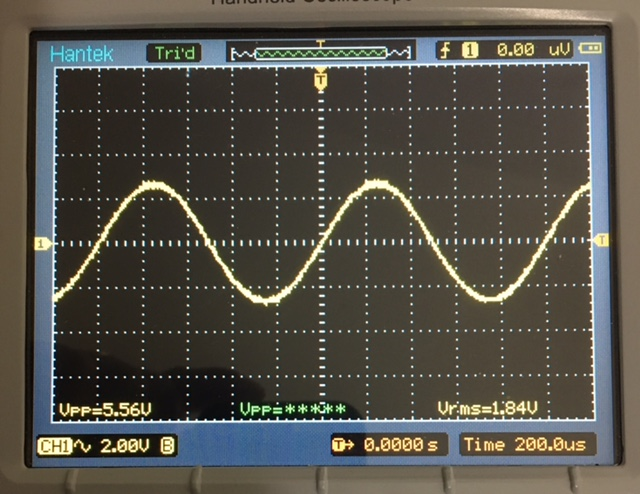
Balanced drive mode (10.0 Vpp):
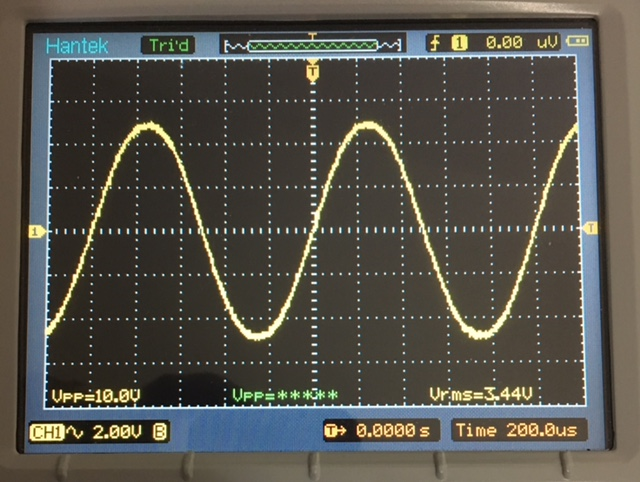
Edit: for the single ended mode, I used the built-in 270R load resistor that is always present on the PCB, and for the balanced mode I have an extra added 270R load externally in between the two outputs. Thus the load is lower impedance in the balanced drive mode and hence max output swing is less.
Single ended drive mode (5.56 Vpp):

Balanced drive mode (10.0 Vpp):

Edit: for the single ended mode, I used the built-in 270R load resistor that is always present on the PCB, and for the balanced mode I have an extra added 270R load externally in between the two outputs. Thus the load is lower impedance in the balanced drive mode and hence max output swing is less.
Attachments
Last edited:
My friend who loaned me the battery powered scope took it back today. My wall plug non-isolated scope doesn't work to measure floating signals. It shows clipping like artifacts. Nonetheless, the Pocket Amp was designed for portability and longer battery life in Class A so then bias was a modest 55mA - suitable for 250ohm and higher headphones. I am certain that clipping will occur at lower voltages than for the 270ohm/180ohm case. If I built some SE Class A headphone amps designed with higher bias for 50ohm headphones, I think it will be fine. Actually I guess I can try it out with my Silicon Harmony, which runs a 1100mA bias current and should handle even 8ohm headphones. I will only get one channel of balanced drive though.
My wall plug non-isolated scope doesn't work to measure floating signals. It shows clipping like artifacts.
Your scope will work just fine. You just gotta know how to use it...
Nonetheless, the Pocket Amp was designed for portability and longer battery life in Class A so then bias was a modest 55mA - suitable for 250ohm and higher headphones.
That'll work well for something like my Sennheiser HD-650 (300 Ω). Not so hot for, say, the Audeze LCD-series (50-60 Ω). Many phones are 32 Ω. Just saying.
Tom
... I'll post some pics of the build as I go and listening impressions at project completion. Meanwhile, my box o' Mouser BOM parts is ready to go!...
Any news to share ...
Playing with colour. This time Carmine Red. I must say that I rather like it. I might just have to hold onto this one for myself. 
I just shipped an HP-1 to Audio Science Review for review. I'd expect the review to be up within the next few weeks or so.
Tom
I just shipped an HP-1 to Audio Science Review for review. I'd expect the review to be up within the next few weeks or so.
Tom
Attachments
Playing with colour. This time Carmine Red. I must say that I rather like it. I might just have to hold onto this one for myself.
I just shipped an HP-1 to Audio Science Review for review. I'd expect the review to be up within the next few weeks or so.
Tom
That’s an original color choice, although the black boxes also look quite the business!
Black on grey yields zero contrast and is impossible to read.
The default LED colour on the HP-1 is blue. I've found the only non-blinding one on Mouser it seems. On the red chassis, I went with a HeNe red, of course.
I did ask a while back which colours people prefer. Colour definitely appeals to many, though when push comes to shove black boxes sell. That's why I've chosen to only have one blue and one red made.
Tom
The default LED colour on the HP-1 is blue. I've found the only non-blinding one on Mouser it seems. On the red chassis, I went with a HeNe red, of course.
I did ask a while back which colours people prefer. Colour definitely appeals to many, though when push comes to shove black boxes sell. That's why I've chosen to only have one blue and one red made.
Tom
Last edited:
...I just shipped an HP-1 to Audio Science Review for review...
New to me but what a interesting site where HP-1 should be in good hands so thanks pointing over there.
...The default LED colour on the HP-1 is blue...
Out of stock mine ended up in green and re below it still sounds great : )
...Colour definitely appeals to many..
In the long run for audio products we probably have to learn and ignore what those eyes often fell in love with is not always the best performer : (
In the long run for audio products we probably have to learn and ignore what those eyes often fell in love with is not always the best performer : (
Olive & Toole demonstrated at Harman Kardon that pretty equipment is perceived to sound better. They also showed that more expensive equipment is perceived to sound better. Both these experiments were scientifically controlled experiments (so double/triple-blind with a significant sample size and proper statistical analysis of the data).
Humans are not rational critters - regardless of our beliefs about our own objectivity.
Tom
- Status
- This old topic is closed. If you want to reopen this topic, contact a moderator using the "Report Post" button.
- Home
- Vendor's Bazaar
- Neurochrome HP-1: Ultra-High End Headphone Amp
